Complete Guide of RICE CULTIVATION Maximum Results from Beginning to Post Harvest
Hay came back with me @jhonmaks. This day finally finished my writing that has been settled for 4 months and I am happy to make this article and share it in steemit.
If you want to know about what I write continue reading this useful article.
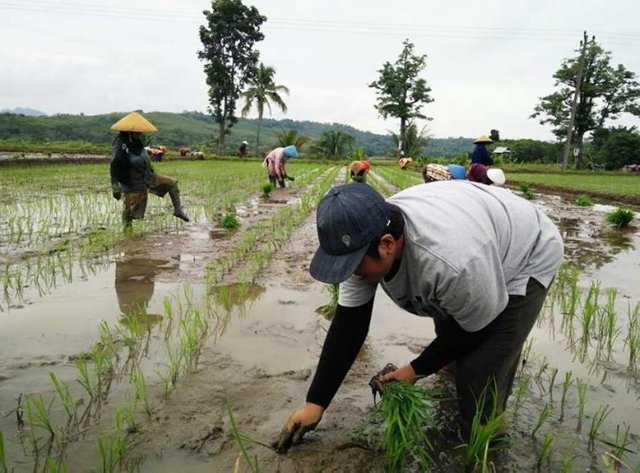
Cultivation of Food Crops
Rice is one of the most important food crops in the world. Rice in Latin is called Oryza sativa L. is one of the most vital cultivation plants in Indonesia. Although world rice production is ranked third after corn and wheat, but rice is the main source of carbohydrate food for most of the world community. In Indonesia alone rice ranks first as a staple food for most people. But unfortunately until now the national rice production has not been able to meet the needs of our society, in other words Indonesia has not been able to berswasembada rice. As an agricultural country with wide rice fields, rice production should be in Indonesia abundant. Minimum for domestic needs. But the fact is very ironic, we still import rice and worse yet Indonesia is the largest rice importer in the world.
The leading rice producing countries are the People's Republic of China (28% of the world's total production), India (21%), and Indonesia (9%). However, only a small percentage of world rice production is traded between countries (only 5% -6% of total world production). Thailand is the main exporter of rice (26% of total world traded rice) followed by Vietnam (15%) and the United States (11%). Indonesia is the world's largest rice importer (14% of the world's traded rice) followed by Bangladesh (4%) and Brazil (3%), Indonesia's rice production in 2006 was 54 million tons, then 2007 was 57 million tons III), missed the original target of 60 million tonnes due to the drought caused by ENSO symptoms. (Wikipedia)
The National Rice Production Enhancement Program (P2BN) is aiming to increase rice production by 5%. This can be done in various ways with the expansion of rice planting area and with intensification. Intensification can be done with the application of PTT (Integrated Crop Management) "which begins with the selection of seeds, a new way of seeding and cultivation because of changing the habits of farmers, with PTT component that is using new varieties / hybrid varieties (seed quality) and the age of young seedlings, leaf color charts, HPT hammer in an integrated manner. The Center for Agricultural Technology Assessment becomes the direct implementer in the field to help introduce some new superior varieties and assist farmers in implementing PTT. The purpose of the application of PTT to increase farmers' income through the application of technology suitable for local conditions that can improve rice yield and rice quality and preserve the environment.
Knowing and understanding the selection of seeds, preparation of nurseries, soil processing,, how to seedlings, how to plant rice paddy will get a healthy plant, high productivity with low input costs. Healthy plants are the main requirements that must be met for high productivity. Therefore, from the beginning, rice plants should be treated as best as possible so that water, nutrients in the available soil can be utilized as much as possible.
A. How to Choose a Good Rice Seed
Quality seed is one of the important technology components to increase rice production and income. Currently obtainable variety of superior varieties that have characteristics in accordance with regional conditions and market desires. Superior varieties have advantages such as high yield potential, resistance to pests and diseases, tolerance to environmental stress. By using quality seed / superior varieties will be obtained seeds healthy, tough (high vigor) with rooting many, seeds grow faster and seeds grow uniformly. How to select good seeds where the seeds are soaked in 20 g / liter ZA solution, then floating / floating seeds are discarded. And the drowning seed is a good seed to cultivate.
B. Preparation of Seedlings and How to Seed the Rice Seed
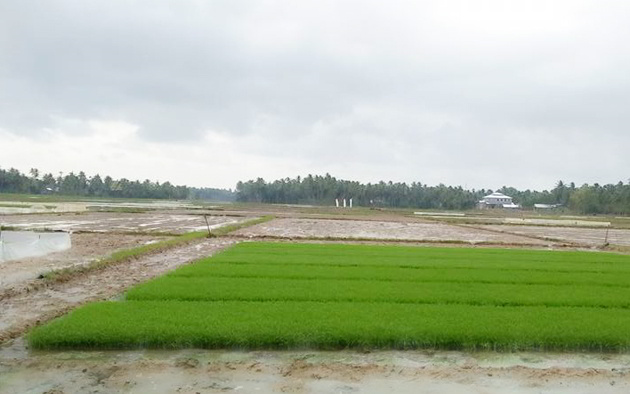
- Create a bed with a width of 1.0 -1.2 m long and tailored to the needs.
-The area of seedbed for 1 hectare of land is 400m2 (4% of planted area), and drainage should be good.
Add 2 kg of organic material such as compost, manure, sawdust and husk that has been decayed / gray).
Nursery done 25 days before the planting period, nursery done on the same land or adjacent to the rice field plot to be planted, this is done so that the seedlings that are ready to be moved, the time is revoked and will be planted easily transported and kept fresh. When the location is remote then the seeds are transported can be stressful even if too long wait will die.
The seeds needed to be planted on an area of 1 ha of 20 kg.
Seeds to be sown beforehand should be perfectly soaked about 2 x 24 hours, in buckets or other containers. This is done so that the seed can suck the water needed for its germination.
Nursery beds are made of 100 m2 / 20 Kg. the land for this nursery had to be processed first, the cultivation of the land for the nursery was done by embracing the soil into the mud and no longer any chunks of soil.
Land that has been smooth mud is then dipetak-plot and between the plots are made of trenches to facilitate water management.
Seed that has been soaked for 2 x 24 hours and has germinated stocked carefully dipersemaian and evenly, it is meant that the seeds that grow do not overlap.
Seeds should not be immersed in the soil because they can cause sprouts infected with pathogens (causes of plant diseases) that can cause spoilage of sprouts.
Fertilization of nursery land is done approximately at the age of one week after planted seed (sow). The fertilizer requirement used is 2.5Kg Urea, 2.5Kg SP36 and 1Kg KCL.
C. Ways of Soil Processing for Land Preparation Rice Field Cultivation
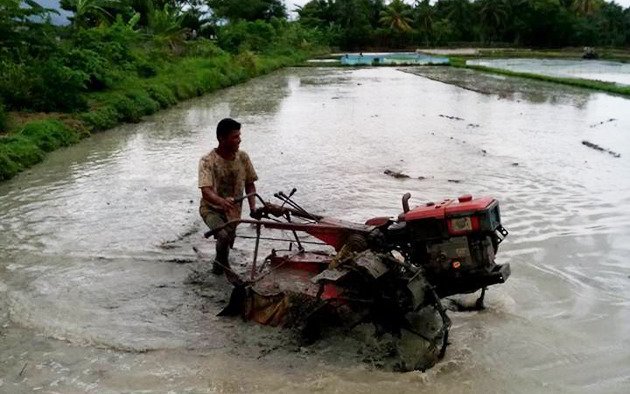
Processing aims to change the physical properties of the soil to the original hard layer becomes flat and muddy. With so weeds will die and rot into humus, soil aeration becomes better, the subsoil becomes water saturated so as to save water. In this wet land preparation, there is also improvement and arrangement of rice field and ditch. Batang (galengan) rice fields are strived to remain good to facilitate the arrangement of irrigation so as not wasteful of water and facilitate the treatment of plants. Stages of wetland farming in principle include the following activities:
- Cleaning.
The paddy fields are cleared of grass, repaired, and made somewhat tall. The main function of bunds at the beginning to hold water during soil tillage is not to flow out the map. The next function is closely related to the regulation of water requirements during the existence of rice plants. Channels or ditches are repaired and cleaned from the grass. The activity aims to facilitate the flow of water and suppress the number of weed seeds carried into the plot. The remaining straw and the remaining crops in the field if cleaned before the soil is processed. The straw can be burned or transported to other places for animal feed, compost, or fuel. Cleansing of plant debris can be done by hand and hoe.
- Embellishment.
After repairs and bunds are done, the next stage is the embankment. The corners of the plot are hoisted to facilitate plow or tractor work. The work is carried out simultaneously with the time of processing soil.
- Piracy.
Piracy and renewal are related activities. Both of these activities aim to make the rice field muddy and ready to be planted with rice. Soil processing is done by using a tractor machine. Before being hijacked, the paddy fields were flooded with water for loose. Long flooding of the rice fields is affected by soil conditions and plant preparation.
Piracy is usually done twice. With this hijacking it is hoped that the clumps of soil are split into small pieces. Clumps of soil are then destroyed with rakes so that it becomes a smooth smooth mud. The profit of the treated land is irrigation water can be evenly distributed. In the wide rice fields, it is necessary to make beds. Between one bed with other beds in the form of small channels. The end of the channel meets a small trench at the edge of the bund which is useful for facilitating irrigation water.
D. Implementation of Planting Rice seedlings in paddy fields
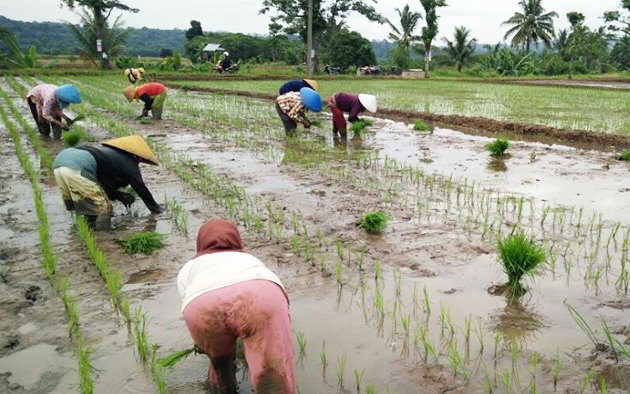
After the preparation of the land is sorted then the seeds are ready to be planted. Seedlings are recommended to be planted as young as possible, usually moved at age 20 days. Characteristics of seedlings that are ready to move is a leaf of 5-6 pieces, 22-25 cm tall, large and hard stems down, free from pests and diseases so that the growth is uniform. Seedlings are planted by being moved from the nursery to the paddy fields, by means of seedlings removed from the nursery beds by keeping the root part carried away and not damaged. After that the seeds are collected in bonds and then put in the field with some roots sinking into the water.
Seedlings are planted with just one seed per planting hole, in an upright position and if the farmer is still unfamiliar with planting one seedlings, in the early stage can plant 2-3 seeds per planting hole, with enough planting depth 2 cm, because if less than 2 cm will drift easily. Setting spacing is done with a tick, plant spacing model tiles are usually 20 cm x 20 cm or 25 cm x 25 cm. Legowo row planting system model has also been widely applied is legowo 2: 1 (40 x 20 x 10 cm) is the way of intermittent cropping 2 lines and 1 bare barrel. The distance between rows of empty plants is called one unit.
E. How to Rice Field Paddy
Soils cultivated continuously tend to lack nutrients for plants, therefore it is necessary addition of nutrients derived from organic fertilizers and inorganic fertilizers. To be effective and efficient use of fertilizer tailored to the needs of plants and the availability of nutrients in the soil. N plant needs can be known by measuring the greenishness of rice leaf color by using Leaf Color Chart.
How to determine the time of application of N fertilizer by using BWD can be done in 2 ways as follows:
The first way is the fixed time, ie the time of fertilization is set first by stage growth of plants, among others the phase at the time of akif tillers and the formation of panicles and when primordia.
The second way is waku fertilizer based on actual BWD reading value that is the use of BWD begins when the plant 14 HST, then periodically repeated 7-10 days once known critical value when N fertilizer must be applied.
F. Care and Maintenance of paddy rice
Care and maintenance of plants is very important in the implementation of rice cultivation. The things that farmers often do are weeding (weed control). Weeds are herbs that live with cultivated plants and are generally very harmful to rice crops. Besides can be a host plant of several pests and causes of disease, weeds are competitors for the nutrients of water, place and sunlight. Moreover weeds have the same root system with rice so that the food elements needed by weeds and rice come from the same soil layer. Weeding weeding done 2 stages, where the first stage of weeding done at the age of the plant approximately 15 days and the second stage at the age of plants aged 30-35 days. Weeding is done by weeding and turned off with or without using tools, usually weeding is done in conjunction with the activities of embroidery.
G. Signs of Paddy Ready Rice and How to Harvest Paddy
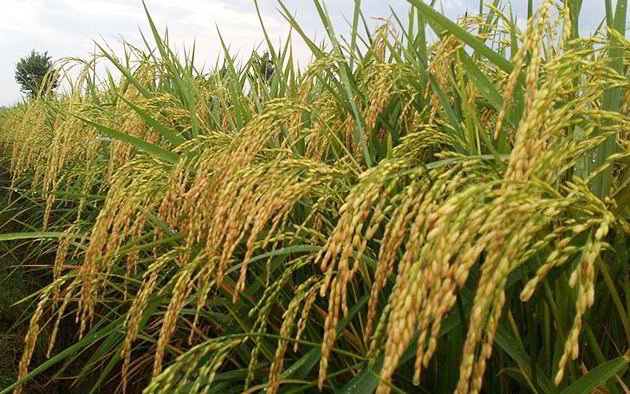
The purpose of harvesting rice is to obtain grain from the field at optimum maturity, prevent damage and loss of yields to a minimum. Harvesting rice will not be profitable and satisfactory if the process is done in a way that is not true and at the age of harvest is not right. Unfavorable harvesting leads to a quantitative loss of yield, while the right harvest will determine the quality of grain and rice. Harvesting should be done when the rice grain is considered enough to cook. Unsatisfactory harvest can reduce the quality of grain and rice.
Characteristics of Paddy Ready Rice;
- The flag leaves have dried out and 95% of the grain has turned yellow.
- Optimum age 30 to 35 days from the day after flowering (HSB). Depending on the varieties that are cultivated.
- Grain water content ranges from 21 - 26%.
- Loss of grain about 16 - 30% (How to measure it by squeezing panicles by hand).
Rice Harvesting Equipment
There are several tools needed to harvest rice, among others, as follows:
- Ordinary skates.
- Squeaky skates.
- Rice harvesting machine such as Reaper.
- Burlap / sack.
- Rope.
How to Harvest Paddy
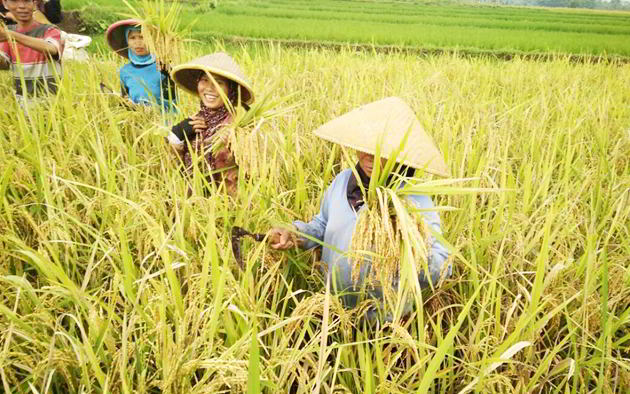
- How to harvest new superior rice varieties with sickle can be done by cutting the top, cut the middle or cut the bottom depending on how threshing.
- How to harvest by cutting down, generally done when threshing the way slam / digebot or use the pedal thresher.
- Harvest rice by cutting the top or cut the middle when done thresher using thresher machine.
H. Post Harvest Paddy
Rice after harvesting is immediately carried out to a place close to the thresher. The place of collection is given a base by using a tarp in order to suppress the loss of results. Rice threshing is the post-harvest stage of rice after cutting or harvesting. The purpose of this stage is to remove the grains from the grass. At the time of grinding threshing there are several things that need to be done are as follows:
- Implementation of threshing should be done as soon as possible after harvest.
- To avoid the amount of grain that is scattered should be used the base, for the base can be used plastic, tarpaulins, woven bamboo or mat.
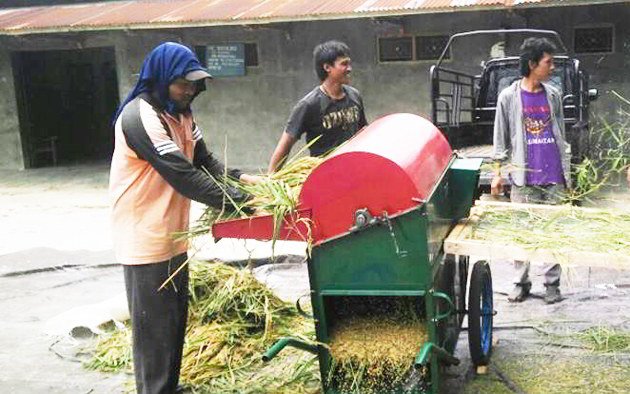
After the rice is harvested the grain should be immediately threshed malainya. Threshing place can be done on the ground or on the home page. This threshing can be done by human labor or by machine tool. Rice threshing is one of the post-harvest stages that contribute significantly to the overall yield loss and quality of rice, therefore it is necessary to find an appropriate thresher alternative so that the rice threshing results produce good quality grain and small yield loss.
How to Thicken Grain
Rice threshing can be done manually or by machine. How to threshing rice can be done in various ways, namely:
- stepped on,
- hit, - slammed,
- pedal tresher / threshing machine / power tresher.
Grain Cleaning
Cleaning is the process of separating rice or grain from foreign matter or other impurities that will damage the seed / grain when stored. The aims and objectives of grain / paddy cleaning are as follows;
- Accelerate drying time. - Minimize the cost of drying.
- Avoid worsening or grain damage during storage.
- Avoid material from conveying and grinding damage.
- Avoid ingredients from grade reduction.
- Minimize the need for space and storage.
Grain drying
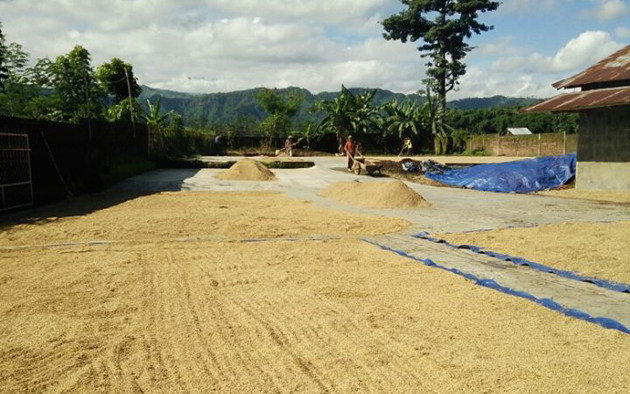
Drying activity is one of the important activities in the effort to maintain the quality of grain. Newly harvested grain water content ranges from 20 - 25%, so it needs to be lowered its water content by drying until the grain reaches a maximum water content of 14%. The purpose of drying is so that the grain is not easily damaged when stored, rendeman milling and the quality remains good. To achieve this objective, the drying should be done immediately after harvesting and threshing to prevent the yellow grains. Grain drying is generally done by exploiting the heat of the sun, but if the harvest occurs during the rainy season it is advisable to use an artificial dryer such as a drayer.
Prior to drying in the sun, it should be noted that the drying places are free of puddles, protected from poultry and other animals. Other factors to note are as follows:
- Drying is done in a place that freely receive sunlight, free from puddles, protected from disturbance of poultry and other animals.
- Make floors drying with surface of cement and made waves.
- If there is a sunny weather the drying of grain should be thickness 5 - 7 cm and backfired once - 2 hours once using tools made of wood or bamboo.
- When using a drying pad, do not use plastic sheeting because it can affect the increase in water content.
- Drying time is recommended starting at 08.00 am until 16.00 hours.
- If drying of large quantities of grain then at night still left on clothesline by digundukkan and covered with plastic, tarpaulin, to avoid rain and dew.
- If the grains are dried in small quantities, grain should be grown indoors by using mat or plastic mat.
After the drying is finished (at 16.00) the grain can be put into the sack and stored in the room if the volume is not much. However, if large volumes of grain can be left outside, but should be stacked and covered with plastic to avoid dew and rain. By way of drying like this for 2 - 3 days in good weather will be obtained grain with moisture content of approximately 14%. Prolonged drying may result in many broken grains during grinding. There are several things to consider in drying, among others, as follows;
- Drying is done as soon as possible after threshing.
The drying area should be exposed to sunlight and free from any chickens or other poultry. - If the weather conditions do not allow for drying, the grain can be heated in the room inside the house.
- To replace heat can be used petromax lamp or other heat source.
- The thickness of the stretch between 2 - 3 cm and the reversal must also be done.
Dry Pad Store
The purpose of storage is to prolong the period of supply of food. Things to consider in storage are as follows:
- Grain stored with maximum water content of 14% clean from dirt, empty grain maximum 3%. - Using a clean and pest-free container bag.
- Warehouses or storage granaries are cultivated to be constructed extending from the east-west direction.
- To avoid the extent of the walls exposed to sun for too long, so the warehouse is quite cool.
- Warehouses or barns must be cleaned from warehouse pests and sprayed with recommended insecticides, including from rodents.
- Air circulation is good enough to keep the humidity and temperature uniform.
- If the floor of the warehouse is made of cement, it must use a wooden pad, in order to avoid direct contact between the grain container with the cement floor.
- Warehouse walls are made in such a way, so as to avoid pests hiding.
Thus "Complete Rice Paddy Farming Guide To Produce Quality Ground". May be useful… Regards @jhonmaks !!!
Thank you for contributing your knowledge to help others! This post has been added to the Sotall.org Directory of Self Sufficiency & Survival posts. One of our goals is to provide access to the knowledge of our fellow Steamians, that will still be seen, long after the 7 day period is passed. If you write any future articles with instructions on how to do any tasks related to a homestead or survival, to ensure they are added to the directory, please submit them. They will be added as soon as possible.